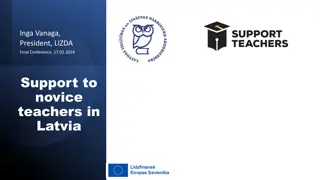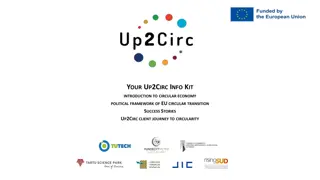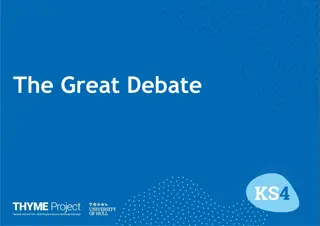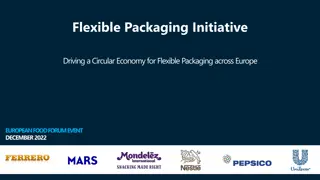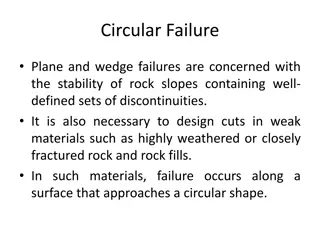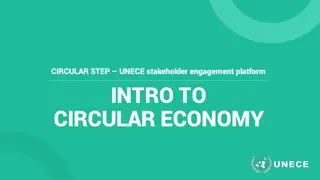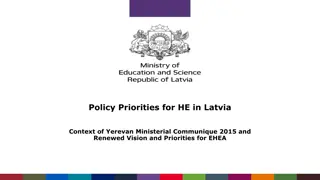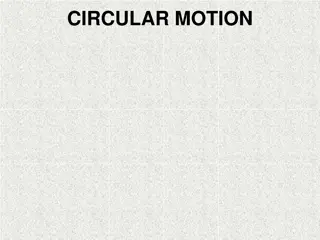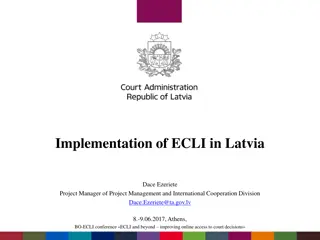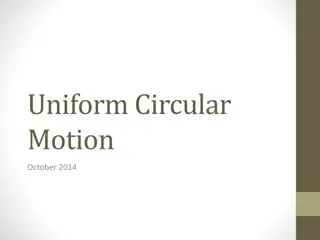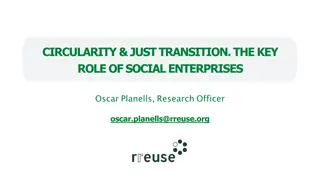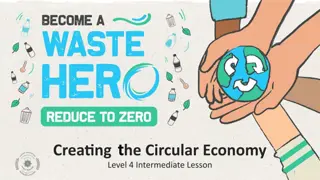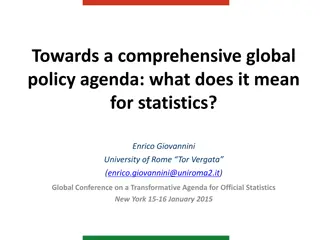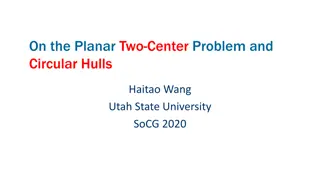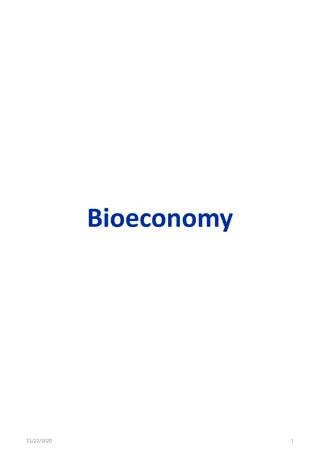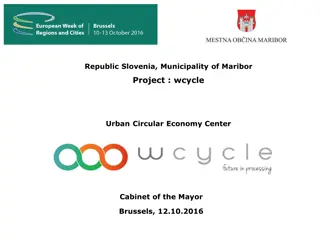Statistical Evidence for Transition to Sustainable Circular Bioeconomy in Latvia
Statistical evidence-based suggestions for transitioning to a sustainable and circular bioeconomy in Latvia are discussed, focusing on aligning national priorities with EU goals including food security, sustainable resource management, reducing non-renewable resource dependence, climate change adaptation, job creation, and competitiveness. The importance of bioeconomy policy, positioning within global supply chains, and the role of bioeconomy in a country's value chains are highlighted. Examples from Latvia's export markets in 2017 indicate the significance of wood products and animal feeds in the bioeconomy sector.
Download Presentation

Please find below an Image/Link to download the presentation.
The content on the website is provided AS IS for your information and personal use only. It may not be sold, licensed, or shared on other websites without obtaining consent from the author.If you encounter any issues during the download, it is possible that the publisher has removed the file from their server.
You are allowed to download the files provided on this website for personal or commercial use, subject to the condition that they are used lawfully. All files are the property of their respective owners.
The content on the website is provided AS IS for your information and personal use only. It may not be sold, licensed, or shared on other websites without obtaining consent from the author.
E N D
Presentation Transcript
Statistical evidence suggestions for transition to sustainable and circular bioeconomy: case Latvia Biljana Kuli i Energy Institute Hrvoje Pozar (EIHP) Dept. RES, Climate and Environmental Protection, Croatia, bkulisic@eihp.hr Markus Lier Natural Resources Institute Finland (Luke) Unit Bioeconomy and Environment, markus.lier@luke.fi
Starting a rapid, policy driven, societal change EU Bioeconomy goals [1] : 1. Ensuring food security 2. Managing natural resources sustainably 3. Reducing dependence on non-renewable resources 4. Mitigating and adapting to climate change 5. Creating jobs and maintaining European competitiveness [2] How to align national priorities with the EU vision?
Statistical evidence based bioeconomy policy: the BIOEAST way using existing data to position bioeconomy towards national priorities Position of a country in the global supply chains Trade balances PRODCOM Structure of the national linear economy Options for decision- makers Synergies Market players on the bioeconom y supply- demand spectrum Embedded bioeconom y in the national linear economy NACE Rev.2
Position in the global value chains: where is the perfect position of your country? Can bioeconomy help? [3] Note: Solid red lines refer to the means for all countries, and the dashed red line refers to the means of the CEE countries.
How important is the current bioeconomy? M [4] Export markets of Latvia in 2017 [5] Pellets and briquettes of pressed and agglomerated wood and of wood waste and scrap 282 16291500 16211800 Other plywood, veneered panels and similar laminated wood, of other wood Pine wood (Pinus sylvestris L.) sawn or chipped lengthwise, sliced or peeled, of a thickness > 6 mm 257 248 16101136 Spruce wood (Picea abies Karst.), fir wood (Abies alba Mill.) sawn or chipped lengthwise, sliced or peeled, of a thickness > 6 mm 209 16101134 Grated, powdered, blue-veined and other non-processed cheese (excluding fresh cheese, whey cheese and curd) Prepared and preserved meat, meat offal or blood, including prepared meat and offal dishes Sausages and similar products of meat, offal or blood and food preparations based thereon (excluding liver sausages and prepared meals and dishes) 104 76 10514050 10131460 Treatment; impregnation and preservation of wood (including seasoning and drying) Preparations for animal feeds (excluding dog or cat food, p.r.s.) 75 74 16109100 104 100000Z1 109010Z0 Prefabricated buildings of wood Other wooden furniture (excluding bedroom, dining-, living-room, kitchen, office, shop, medical, surgical, dental/veterinary furniture, cases and cabinets designed for hi-fi, videos and televisions) 70 Wood, sawn or chipped lengthwise, sliced or peeled, of a thickness > 6 mm (excluding coniferous and tropical woods and oak blocks, strips and friezes) 16232000 97 95 16101250 16241133 Flat pallets and pallet collars of wood 70 31091300 Crustaceans, molluscs and other aquatic invertebrates and seaweed, frozen, dried, salted, in brine or otherwise prepared or preserved; Fish, otherwise prepared or preserved; Prepared meals and dishes based on fish, crustaceans and molluscs Cake and pastry products; other bakers wares with added sweetening matter 68 10711200 88 Doors and their frames and thresholds, of wood 67 100000Z4 16231150 1st30 = 50% total value: Fresh bread containing by weight in the dry matter state 5 % of sugars and 5 % of fat (excluding with added honey; eggs; cheese or fruit) 81 10711100 17 bio-based products or potentially bio-based products (38% value) 10 wood-based products (34%) 6 farm-fork products (11% value) 1 blue economy (2%) - - - 1st10 products/289 = 34% total value 10/10 bio-based
Doing more with less: Synergies with bioeconomy strategy: Synergy with industry strategy in bio-based and potentially bio-based industries. Overview of energy sector to investigate the needs for synergies with decarbonisation strategy [6] Relative energy intensity (EU27=100): 108 Energy sources by type: give priority to fuel-less energy sources; bioenergy use only when no other renewable source can perform (e.g. high temperatures, process heat, biofuels) or in a synergy (e.g. biogas with freshwater aquaculture) Energy dependency: reduced to 47.2% in 2016 Prices of energy for industry: LV pays higher electricity prices than: HR; FR, PL, RO, HU, SK, NL, LT, EE, LU, BG, CZ, SE, FI, DK LV pays higher natural gas prices than: RO, BG, ES, GR, HR, CZ, HU, BE What are the most GHG air emitting sectors? Overview of labour force to investigate the needs for synergies with educational & demographics strategy [7] Net migration Population projections PPP Innovation attractiveness scoreboards [8] Who are the current and emerging bioeconomy players in your country?
The highest CO2e emitting sectors in Latvia [9] 1. H Transportation and storage: 38% (17% of GVA; 16% of employment) 2. D Electricity, gas, steam and air conditioning supply: 27% (5% of GVA; 2% of employment) 3. C Manufacture: 18% (23% of GVA; 21% of employment) + = 83% CO2e in total In Latvia, that would mean 39% of the workforce and 55% of the GVA, excluding the public sector.
The state of the art of bioenergy in Latvia [10,11] - 1.046 GWh primary production of biogas - 570 GWh of electricity from solid biofuels 36.7 ktoe of total consumption from biofuels in transport - 9.7 ktoe bioethanol - 27.0 ktoe biodiesel 2.4 Mtoe from solid biomass primary energy production 1.5 Mtoe from solid biomass gross inland consumption Bioelectricity generates ~320 direct jobs in Latvia [12]
[13,14] Source [16]
VA per employed person in the Latvian bioeconomy, by sector 1.8 1.6 1.4 1.2 1 = Average VA per employee for LV bioeconomy 1.0 0.8 bC16-bC31 Manufacture of wood and wooden furniture: 29% higher VA per employee 0.6 0.4 0.2 Source [12,15,16] 0.0
bC2059 Manufacture of other bio-based chemical products n.e.c. 3 bC1621 Manufacture of bio-based veneer sheets and wood-based panels Manufacture of oils and fats Distilling, rectifying and blending of spirits Manufacture of condiments and seasonings 2.758 C1041 113 Bioeconomy champions in LV [12,15,16] C1101 751 C1084 340 bC2030 Manufacture of bio-based paints, varnishes and similar coatings, printing ink and mastics Manufacture of prepared feeds for farm animals bC1629 Manufacture of other wood; manufacture of bio-based articles of cork, straw and plaiting materials 4 C1091 298 1.909 bC2211 Manufacture of bio-based rubber tyres and tubes; retreading and rebuilding of rubber tyres bC1721 Manufacture of corrugated paper and paperboard and of containers of paper and paperboard 13 758 bC2222 Manufacture of bio-based plastic packing goods bC1729 Manufacture of other articles of paper and paperboard bC2015 Manufacture of bio-based fertilisers and nitrogen compounds Operation of dairies and cheese making Processing of tea and coffee bC1610 Sawmilling and planing of wood Manufacture of cocoa, chocolate and sugar confectionery Manufacture of beer Manufacture of soft drinks; production of mineral waters and other bottled waters bC2014 Manufacture of other bio-based organic basic chemicals 2 437 285 C1051 3.114 C1083 198 6.00 12.632 C1082 1.171 5.00 C1105 734 C1107 925 532 4.00 3.00 2.00 1.00 0.00
Statistical evidence based bioeconomy policy options for Latvia 1. Bio-based products highly represented in the PRODCOM transition to sustainable and circular bioeconomy: linking with the Clean Energy transition to ensure carbon neutrality and reduce price of electricity, energy dependency (National Climate Energy Action Plan) and sustainability certification schemes (FSC ) 4.2 2. Investigating if there is a chance for growth through Farm to Fork by linking primary production with the industry that produces PRODCOM products NA 3. Capacity to develop both blue, green and brown bioeconomy: focusing on those that are having greater value added 4.5 4.7 4. Blue bioeconomy (2% of VA and 37% above the average) as a competitive advantage to provide biomass base to support bioeconomy champions: R&D waste streams and algae 5. Wood-based bioeconomy (51% of VA and 36% above the average) with cascading use of biomass and heat from bioenergy (CHP) or high-temperature heat pumps to improve the competitiveness & carbon neutrality untapped potential with a source of renewable CO2! 4.3 6. Biomass exchange / bio-hubs: BALTPOOL - LT 4.2 7. Farm to fork : 43% of VA, 68% of average VA: focus on dairy industry (28% higher VA/emp. than national average) and top PRODCOM products to transition to S&C bioeconomy spin offs and decarbonisation 4.2 8. Transition of non - integrated biorefineries to bioeconomy to support transition of the top bio-based PRODCOM products & bioeconomy champions 4.6 9. Strong education & focusing on high-VA bio-based industries with less labour intensity / vocational training. 4.3
2050: a sustainable, carbon-neutral society Foresight Exercise 2030 National Bioeconomy Action Plan & SRIA evidence-based statistical data, verified by the national stakeholders 2020
Sources: [1] EC: Review of the 2012 European Bioeconomy Strategy, DG RTD, COM(2018) 763 final. Available at: https://ec.europa.eu/research/bioeconomy/pdf/review_of_2012_eu_bes.pdf#view=fit&pagemode=none [2] COMMUNICATION FROM THE COMMISSION TO THE EUROPEAN PARLIAMENT, THE EUROPEAN COUNCIL, THE COUNCIL, THE EUROPEAN ECONOMIC AND SOCIAL COMMITTEE AND THE COMMITTEE OF THE REGIONS The European Green Deal. COM/2019/640 final; available at https://eur-lex.europa.eu/legal- content/EN/TXT/?qid=1576150542719&uri=COM%3A2019%3A640%3AFIN [3] Vidakovi Peru ko, I.; Kova , K.; Jo i M. Croatia in Global Value Chains. Surveys S-32; Croatian National Bank, Zagreb, February 2018 [4] Eurostat: PRODCOM Annual Dana 2019, available at: https://ec.europa.eu/eurostat/documents/120432/10398214/Prodcom+Annual+Data+2019/9e1da95d-1223-a4e0-6bcf-839c33bffd85 [5] OECD Country profile: Croatia, available at: https://oec.world/en/profile/country/hrv/, accessed at 23 February 2020. [6] Eurostat: Shedding light on energy in the EU - A GUIDED TOUR OF ENERGY STATISTICS, 2020 Edition, https://ec.europa.eu/eurostat/cache/infographs/energy/bloc-4b.html [7] Lutz, W., Amran, G., Belanger, A., Conte, A., Gailey, N., Ghio, D., Grapsa, E., Jensen, K., Loichinger, E., Marois, G., Muttarak, R., Potancokova, M., Sabourin, P. and Stonawski, M., Demographic Scenarios for the EU, EUR 29739 EN, Publications Office of the European Union, Luxembourg, 2019, ISBN 978-92-76-03216-8 [8] European innovation scoreboard https://ec.europa.eu/growth/industry/policy/innovation/scoreboards_en#:~:text=The%20European%20innovation%20scoreboard%20provides,areas%20they%20need%20to%20address. [9] Eurostat: Greenhouse gas emission statistics - air emissions accounts; https://ec.europa.eu/eurostat/statistics-explained/index.php?title=Greenhouse_gas_emission_statistics_- _air_emissions_accounts [10] Eurobserv er, 2020: Biofuels Barometer. Available at: https://www.eurobserv-er.org/category/all-biofuels-barometers/ [11] Bioenergy Europe, 2020. Statistical Report 2019. Available at: https://bioenergyeurope.org/article/101-statistical-report-2019.html [12] JRC, Socioeconomic Indicators to Monitor the EU s Bioeconomy in Transition; https://datam.jrc.ec.europa.eu/datam/mashup/BIOECONOMICS/index.html?rdr=1591178537080 [13] Gurr a, P., Ronzon, T., Tamosiunas, S., L pez, R., Garc a Condado, S., Guill n, J.,Cazzaniga, N. E., Jonsson, R., Banja, M., Fiore, G., M'Barek R., Biomass flows in the European Union: The Sankey Biomass diagram- towards a cross-set integration of biomass, EUR 28565 EN, doi:10.2760/352412 available at https://datam.jrc.ec.europa.eu/datam/mashup/BIOMASS_FLOWS/index.html# [14[ JRC: Biomass flows: https://knowledge4policy.ec.europa.eu/visualisation/biomass-flows_en [15] Ronzon, T.; Piotrowski, S.; Tamosiunas, S.; Dammer, L.; Carus, M.; M Barek, R. Developments of Economic Growth and Employment in Bioeconomy Sectors across the EU. Sustainability 2020, 12, 4507. [16] Gurr a, P., Ronzon, T., Tamosiunas, S., L pez, R., Garc a Condado, S., Guill n, J.,Cazzaniga, N. E., Jonsson, R., Banja, M., Fiore, G., M'Barek R., Biomass flows in the European Union: The Sankey Biomass diagram- towards a cross-set integration of biomass, EUR 28565 EN, doi:10.2760/352412 available at https://datam.jrc.ec.europa.eu/datam/mashup/BIOMASS_FLOWS/index.html#
Thank you for your attention www.bioeast.eu/bioeastsup This project has received funding from the European Union s Horizon 2020 research and innovation programme under Grant Agreement No 862699



